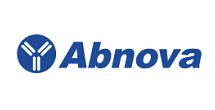GRAP2 & CSF1R Protein Protein Interaction Antibody Pair



* The price is valid only in USA. Please select country.
-
More Files
- More Functions
-
Specification
Product Description
This protein protein interaction antibody pair set comes with two antibodies to detect the protein-protein interaction, one against the GRAP2 protein, and the other against the CSF1R protein for use in in situ Proximity Ligation Assay. See Publication Reference below.

Reactivity
Human
Quality Control Testing
Protein protein interaction immunofluorescence result.
Representative image of Proximity Ligation Assay of protein-protein interactions between GRAP2 and CSF1R. HeLa cells were stained with anti-GRAP2 rabbit purified polyclonal antibody 1:1200 and anti-CSF1R mouse monoclonal antibody 1:50. Each red dot represents the detection of protein-protein interaction complex. The images were analyzed using an optimized freeware (BlobFinder) download from The Centre for Image Analysis at Uppsala University.
Supplied Product
Antibody pair set content:
1. GRAP2 rabbit purified polyclonal antibody (100 ug)
2. CSF1R mouse monoclonal antibody (40 ug)
*Reagents are sufficient for at least 30-50 assays using recommended protocols.Storage Instruction
Store reagents of the antibody pair set at -20°C or lower. Please aliquot to avoid repeated freeze thaw cycle. Reagents should be returned to -20°C storage immediately after use.
-
Applications
In situ Proximity Ligation Assay (Cell)
-
Gene Info — CSF1R
Entrez GeneID
1436Gene Name
CSF1R
Gene Alias
C-FMS, CD115, CSFR, FIM2, FMS
Gene Description
colony stimulating factor 1 receptor
Omim ID
164770Gene Ontology
HyperlinkGene Summary
The protein encoded by this gene is the receptor for colony stimulating factor 1, a cytokine which controls the production, differentiation, and function of macrophages. This receptor mediates most if not all of the biological effects of this cytokine. Ligand binding activates the receptor kinase through a process of oligomerization and transphosphorylation. The encoded protein is a tyrosine kinase transmembrane receptor and member of the CSF1/PDGF receptor family of tyrosine-protein kinases. Mutations in this gene have been associated with a predisposition to myeloid malignancy. The first intron of this gene contains a transcriptionally inactive ribosomal protein L7 processed pseudogene oriented in the opposite direction. [provided by RefSeq
Other Designations
CD115 antigen|FMS proto-oncogene|McDonough feline sarcoma viral (v-fms) oncogene homolog|macrophage colony stimulating factor I receptor|soluble CSF1R variant 1
-
Gene Info — GRAP2
Entrez GeneID
9402Gene Name
GRAP2
Gene Alias
GADS, GRAP-2, GRB2L, GRBLG, GRID, GRPL, GrbX, Grf40, Mona, P38
Gene Description
GRB2-related adaptor protein 2
Omim ID
604518Gene Ontology
HyperlinkGene Summary
This gene encodes a member of the GRB2/Sem5/Drk family. This member is an adaptor-like protein involved in leukocyte-specific protein-tyrosine kinase signaling. Like its related family member, GRB2-related adaptor protein (GRAP), this protein contains an SH2 domain flanked by two SH3 domains. This protein interacts with other proteins, such as GRB2-associated binding protein 1 (GAB1) and the SLP-76 leukocyte protein (LCP2), through its SH3 domains. Transcript variants utilizing alternative polyA sites exist. [provided by RefSeq
Other Designations
GRB-2-like protein|GRB2-related protein with insert domain|OTTHUMP00000028837|SH3-SH2-SH3 adaptor molecule|growth factor receptor-binding protein|growth factor receptor-bound protein 2-related adaptor protein 2|hematopoietic cell-associated adaptor protei
-
Interactome
-
Pathway
-
Disease
- +1-909-264-1399
+1-909-992-0619
Toll Free : +1-877-853-6098 - +1-909-992-3401
- sales@abnova.com















